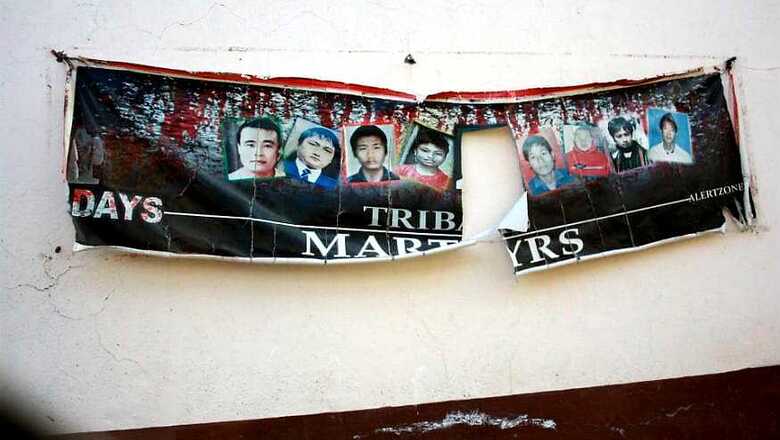
views
Blockades embitter entire populations. They hit the section of society from where the blockade starts, in this case, the tribals living in the Hill districts of Manipur. The blockade then manifests along empty roads and highways. No trucks ply, no goods reach their destination.
The population that is also squeezed thin are those that reside in the Valley, Imphal for instance. They stand in line, night and day, parking their vehicles overnight and wait for a token which will allow a measly dole of fuel. Cars get the freshly minted five hundred rupees worth of fuel while scooters have to do with 300 rupees. Blockades are an annual ritual in Manipur, only this time they are intersecting with elections. Manipur votes on the 4th and 8th of March. The blockade would have gone on for more than four months.
Contrary to popular (or mainstream media’s) perception, a blockade in Manipur does not mean a long meandering queue of trucks that are unable to pass through. That happened only in the first few days, when trucks coming in from Mao Gate bordering Nagaland were prevented from entering Senapati and traveling to Imphal for where the goods were meant for.
The agitational dynamics of the blockade have been perfected over the years. Now trucks simply don’t attempt to enter via Mao Gate once the first bugle of a blockade has been sounded. They instead prefer choosing a longer, arduous route. As a result fuel supplies are delayed and there is despair in both the Hills and the Valley.
New Districts Trigger Manipur’s Latest Blockade
The Manipur election battlelines although distinct now, are still complex.
Quite naturally those who go to cast their vote are likely to have the economic blockade called by the United Naga Council (UNC) on top of their mind.
The district status for Sadar Hills and Jiribam have been a long standing demand of the Kukis (tribals in Hills) and Meiteis (residing in the Valley). The UNC has been vehemently opposed to it. The Nagas consider Senapati a part of the Naga ancestral homeland and therfore are against the bifurcation.
Did the Chief Minister Play the UNC?
Anticipating protests and blockades, perhaps even preempting them, the Ibobi government went ahead and announced the creation of seven new districts. What better time than elections to do this, especially if it shifted attention from anti-incumbency, charges of misrule and corruption and brought the focus back to ethnic tensions and strained tribal unity. Five of these districts were going to be formed by splitting Hill districts and two by bifurcating Valley districts.
As expected, the United Naga Council (UNC), an umbrella organisation of Naga civil society organisation fell for it, imposing a blockade on National Highway 2 and 37 that connect Imphal to Dimapur and Jiribam respectively. For days, even 100 days on, young men in small groups would stand along the road from Senapati to Imphal stopping vehicles, ensuring no food, or items for commerical usage pass.

Tribal unity under strain (Picture Courtesy: Anubha Bhonsle/CNN-News18)
Administrative efficiency was the reason given by the Ibobi government for the decision that came at the fag end of the tenure. “It doesn't matter if it is the end, even if it is one week, we are the government and we can make this decision”, Kh Joykishan, the Congress spokesperson said. The blockade impacts not just people in the Valley but also the Hills, where the UNC has its support base. So why protest through a blockade, which hurts the Meiteis in the Valley, but also the Nagas in the Hills, your own people, I ask the former head of the UNC, L. Adani.
“This blockade isn’t aimed at any particular community. For Nagas, land is very important. It gives us our sense of identity, our culture and value. And we have demonstrated it many times in the past that we are sensitive to this. The creation of these new districts is an attack on this. We reject the creation of these districts in toto. But the creation of Kangpokpi which is a new name for Sadar Hills is a big bone of contention,” Adani says.
The UNC speaks the same tone as the the NSCN-IM but Adani often insists of their independence from the underground group through our conversation
Just short of Senapati, is the Kangpokpi district that Adani is referrring to. There are no signs of administrative infrastructure that the state government is referring to that could improve efficiency, but most shops have done quick paint jobs and changed their district name.
What was once Senapati is now Kangpokpi. Privately members of the UNC tell me that out of all the newly created districts---Kangpokpi, Tengnoupal, Noney, Kamjong, Pherzawl, Jiribam and Kakching, the first two are most problematic and the toughest for the Nagas to accept. With the creation of the new districts, the Chief Minister also managed to divide tribal unity and appease the earlier unhappy Kukis, who are no longer against the government after their long-time demand of Sadar Hills district was granted in the form of Kangpokpi.
In the non-Naga districts of Churachandpur, Thoubal and Imphal East, which too have been split, the government’s move has been welcomed.
Who Ends the Blockade: No one.
It would be obvious to think that ahead of elections both the BJP and the Congress would want to end the blockade and take credit for ending hardships of the people. In Manipur, the obvious is sometimes a smokescreen. The blockade has become a political hot potato, with both sides saying they are doing all they can to end it.
“Law and order is a state subject. When the economic blockade began, I myself called him [Manipur Chief Minister], up several times and told him we will extend all help to lift it. I told the state to sit for tripartite talks with the UNC and the Centre. We have given the state enough central forces but they are not using them,” Rajnath Singh said in Imphal soon after the release of the party’s vision document. In response the Congress is at its sharpest best, attacking the Centre of forcing them to sit with the UNC, who is nothing but a terror organization.
“They can convince the UNC to call it off. Why are they not doing that? The UNC are representative of terrorist organization NSCN-IM. They are under pressure. Why have no details of the NSCN-IM framework agreement been released to us,” Kh Joykishan said, a day after it became clear that two rounds of tripartite talks [between Centre, UNC and Manipur government] had resulted in no breakthrough. The UNC will never say anything positive for the Manipur government. We have no choice to but to sit in these talks,” he added.
While some political observers say a longer blockade works to the advantage of the Chief Minister, who has used the same strategy in the past as well. In 2012, he won a record 42 seats. This was soon after a 120 day economic blockade.
Worse, many say the Valley has little stake in the politics in the hill districts or the creation of new districts, except when it comes to the NSCN-IM’s pursuit of a “Nagalim” or a greater Nagaland carved out of Naga dominated areas of Manipur and other neighbouring states merging with Nagaland.
Is the NSCN-IM framework agreement hurting the BJP?
In August, 2015, NSCN-IM and the government of India signed a “framework agreement” at 7RCR in presence of Prime Minister Modi and the NSCN-IM chief Th Muivah. The I of the IM Isaak Chisi Swu was admitted to a South Delhi hospital that time. He died a few months later.
The contents of the framework agreement have remained hidden from the public adding to the political intrigue this election. The Congress often speaks of it, accusing the BJP and the Central government of working against Manipur’s interests. Privately, state BJP leaders admit the “framework agreement” has put them in a tough spot. Of the 60 seats in the Manipur assembly, 40 are in the valley.
“A Hindu party is being seen as aligining with the Christian faith Nagas in Manipur, while the Meiteis, who are Hindu or Sanamahi, are seen to be close to the Congress. We have not managed to break that.” It was clear he was not an isolated voice. The party was feeling the strain of explaining the NSCN-IM arrangement when Rajnath Singh said, that the statement government was trying to “fool people” by spreading canards.
“I want to reassure you here that the Central government and the BJP will never compromise with the territorial integrity of Manipur. In the framework agreement, even the name of Mnipur is not there. So why are they spreading lies?” Singh said.














Comments
0 comment